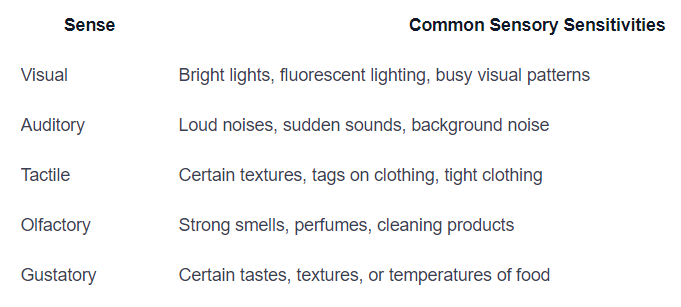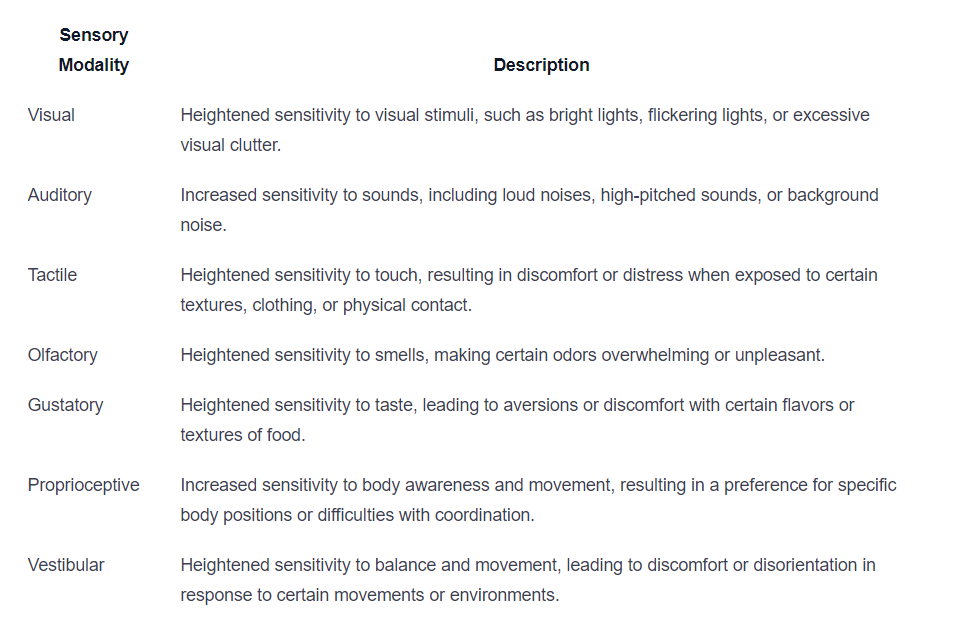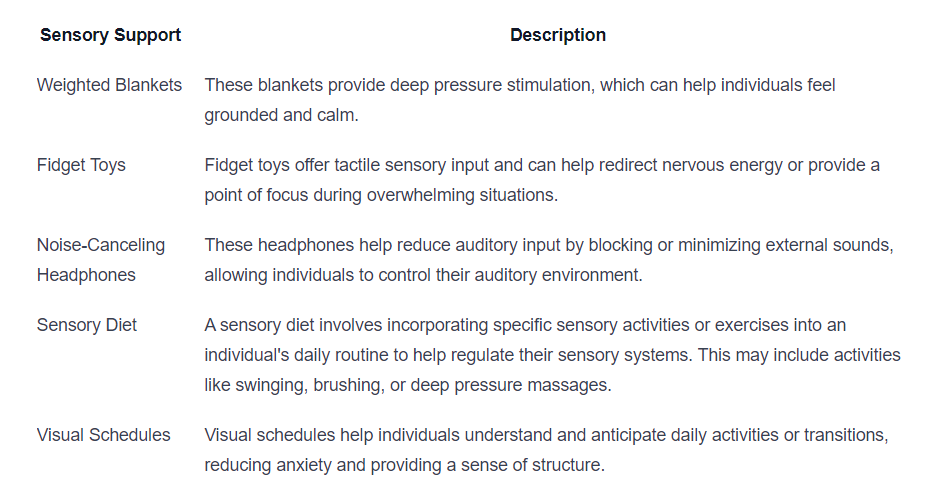Sensory Overload in Autism: Sensitivity Differences
Unveiling sensory overload in autism: Discover how sensitivity differences impact individuals and learn coping strategies for support.

Understanding Sensory Overload in Autism
Sensory overload is a common experience for individuals with autism, where the brain becomes overwhelmed by sensory information from the environment. This can lead to difficulties in processing and responding to sensory stimuli. Understanding sensory overload is crucial in providing support and creating sensory-friendly environments for individuals with autism.

What is Sensory Overload?
Sensory overload refers to an overwhelming amount of sensory input that exceeds an individual's ability to process and integrate it effectively. It occurs when the brain receives an abundance of information from the senses, such as sight, sound, touch, taste, and smell, all at once or at an intense level. This influx of sensory information can be distressing and disruptive, leading to feelings of anxiety, discomfort, and even physical pain.
How Does Sensory Overload Manifest in Autism?
In autism, sensory overload manifests differently in individuals. While everyone has unique sensory sensitivities, individuals with autism often experience heightened sensory sensitivities, making them more susceptible to sensory overload. These sensitivities can affect any or multiple senses, including:

The manifestation of sensory overload can vary from person to person. Some individuals may become overwhelmed and exhibit behavioral responses, such as covering their ears, avoiding certain environments, or engaging in repetitive behaviors. Others may internalize the overload, leading to increased anxiety or a shutdown where they withdraw and become unresponsive.
Understanding sensory overload and its manifestation in autism is crucial for creating supportive environments and implementing strategies to help individuals with autism manage their sensory sensitivities effectively. By recognizing the signs of sensory overload and implementing appropriate coping strategies, we can support individuals with autism in navigating their sensory experiences and improving their overall well-being.
Sensory Sensitivities in Autism
Individuals with autism often experience heightened sensory sensitivities, which can contribute to sensory overload. Understanding these sensitivities is essential in creating a supportive environment for individuals on the autism spectrum.
Heightened Sensory Sensitivities
People with autism frequently have a heightened sensitivity to sensory stimuli, meaning they may experience sensory information more intensely than individuals without autism. This heightened sensitivity can make everyday sensory experiences overwhelming and challenging to navigate.
To gain a better understanding of the sensory sensitivities in autism, let's explore the different types of sensory experiences that individuals with autism might struggle with.
Types of Sensory Sensitivities
People with autism can experience sensitivities across various sensory modalities. Here are some common types of sensory sensitivities:

Understanding these sensory sensitivities is crucial in providing appropriate support and accommodations for individuals with autism. By recognizing and addressing these sensitivities, we can help create environments that are more comfortable and conducive to their well-being.
In the next sections, we will explore the impact of sensory overload and discuss coping strategies and support techniques to help individuals with autism navigate their sensory sensitivities.
Impact of Sensory Overload
Sensory overload can have a significant impact on individuals with autism, affecting their behavior and presenting various challenges. Understanding these impacts is crucial in providing support and creating a more inclusive environment. Let's explore the behavioral responses to sensory overload and the challenges faced by individuals with autism.
Behavioral Responses to Sensory Overload
When faced with sensory overload, individuals with autism may exhibit a range of behavioral responses. These responses can vary depending on the individual and the specific sensory stimuli that trigger the overload. Some common behavioral responses include:
- Avoidance: Individuals may try to escape or avoid the overwhelming sensory environment by moving away, covering their ears, or shutting their eyes.
- Meltdowns: Sensory overload can lead to meltdowns, which are intense emotional outbursts characterized by crying, screaming, or even physical aggression. These meltdowns are often a result of the overwhelming sensory input.
- Shutdowns: In some cases, individuals may experience a shutdown, where they withdraw and become unresponsive. This is a self-protective response to sensory overload and can manifest as appearing distant or unengaged.
- Repetitive behaviors: To cope with sensory overload, individuals may engage in repetitive behaviors such as rocking, hand-flapping, or self-stimulatory movements. These behaviors can provide a sense of comfort and help regulate sensory input.
It's important to note that these behavioral responses are not deliberate or attention-seeking but are instead a natural reaction to the overwhelming sensory stimuli.
Challenges Faced Due to Sensory Overload
Sensory overload poses numerous challenges for individuals with autism, affecting their daily lives and overall well-being. Some common challenges include:
- Communication difficulties: When experiencing sensory overload, individuals may find it challenging to communicate their needs or emotions effectively. This can lead to frustration and difficulty in expressing themselves to others.
- Social interactions: Sensory overload can impact social interactions, making it difficult for individuals with autism to engage in conversations or participate in group activities. They may struggle to process verbal and non-verbal cues, leading to feelings of isolation or social anxiety.
- Academic performance: Sensory overload can significantly impact learning and academic performance. The overwhelming sensory input can make it challenging for individuals to concentrate, leading to difficulties in processing and retaining information in educational settings.
- Daily functioning: Sensory overload can also affect daily activities such as eating, sleeping, and self-care routines. The overwhelming sensory stimuli can disrupt eating patterns, sleep schedules, and personal hygiene practices, impacting overall well-being.
Understanding the behavioral responses and challenges associated with sensory overload in autism is essential for creating a supportive and inclusive environment. By recognizing and accommodating sensory sensitivities, it becomes possible to provide appropriate support and promote the overall well-being of individuals with autism.
Recognizing Signs of Sensory Overload
Recognizing the signs of sensory overload in individuals with autism is crucial for understanding their experiences and providing appropriate support. Sensory overload can manifest through both physical and behavioral signs, which can vary from person to person. By being aware of these signs, we can better identify when someone may be experiencing sensory overload and take steps to alleviate their discomfort.
Physical Signs
Physical signs of sensory overload can manifest in various ways. Individuals may exhibit heightened sensitivities to certain sensory stimuli, leading to noticeable physical reactions. Some common physical signs of sensory overload in autism include:
Physical Signs
Covering ears or eyes
Clenching fists
Flinching or jumping at sudden noises or touches
Hypersensitivity to certain textures, smells, or tastes
Increased heart rate or breathing
Feeling physically overwhelmed and needing to retreat to a quieter space
It's important to note that not all individuals with autism will exhibit the same physical signs of sensory overload. Each person may have unique sensitivities and reactions to different sensory stimuli.
Behavioral Signs
In addition to physical signs, behavioral signs can also indicate sensory overload in individuals with autism. These behavioral signs are often a result of the overwhelming sensory input that they are experiencing. Some common behavioral signs of sensory overload in autism include:
Behavioral Signs
Restlessness or fidgeting
Irritability or aggression
Withdrawal or avoidance of certain situations or environments
Difficulty focusing or concentrating
Meltdowns or tantrums
Increased anxiety or stress levels
It's important to approach behavioral signs with empathy and understanding. It is not uncommon for individuals with autism to exhibit these behaviors when they are overwhelmed by sensory input. Providing a supportive and calming environment can help them regulate their sensory experiences and reduce the impact of sensory overload.
By recognizing these physical and behavioral signs of sensory overload in individuals with autism, we can respond in a manner that promotes their well-being and comfort. Creating sensory-friendly environments and implementing sensory regulation techniques can greatly benefit individuals with autism and help them navigate their sensory sensitivities more effectively.
Coping Strategies for Sensory Overload
Individuals with autism who experience sensory overload can benefit from various coping strategies to manage their heightened sensitivities. These strategies aim to create sensory-friendly environments and employ sensory regulation techniques to help reduce overwhelm and promote well-being.
Sensory-Friendly Environments
Creating sensory-friendly environments can significantly alleviate sensory overload for individuals with autism. These environments are designed to minimize sensory triggers and provide a more comfortable and predictable experience. Here are some key elements to consider when creating sensory-friendly spaces:
- Lighting: Utilize soft and diffused lighting to reduce harsh glare and flickering. Natural light or warm, dimmed lighting can be soothing for individuals with sensory sensitivities.
- Sound: Minimize background noise by using sound-absorbing materials or providing noise-cancelling headphones. Creating quiet areas or implementing white noise machines can also help create a calm environment.
- Visuals: Reduce clutter and excessive visual stimuli by organizing and decluttering the space. Use neutral colors and avoid patterns that may be visually overwhelming. Providing visual schedules or visual cues can also aid in promoting predictability.
- Tactile Sensations: Offer a variety of tactile experiences, such as soft fabrics or textured surfaces, to cater to different sensory preferences. Providing sensory tools like fidget toys or weighted blankets can also offer comfort and regulation.
- Scent: Be mindful of strong scents or fragrances that may be overpowering. Opt for neutral or mild scents, if necessary, and ensure good ventilation to maintain a pleasant sensory environment.
By creating sensory-friendly environments, individuals with autism can feel more comfortable and have a reduced likelihood of experiencing sensory overload.
Sensory Regulation Techniques
Sensory regulation techniques are helpful tools that individuals with autism can use to self-regulate and manage sensory overload. These techniques aim to provide a sense of control and promote relaxation. Here are some commonly used sensory regulation techniques:
- Deep Pressure: Applying deep pressure through activities like weighted vests, compression clothing, or tight hugs can provide a calming effect and help regulate the sensory system.
- Deep Breathing: Deep breathing exercises, such as diaphragmatic breathing or square breathing, can promote relaxation and reduce stress. Encouraging slow, deep breaths can help individuals manage sensory overload.
- Sensory Diet: A sensory diet involves engaging in specific sensory activities throughout the day to maintain a regulated state. This may include activities such as swinging, bouncing on exercise balls, or using sensory tools like fidget spinners or chewable items.
- Self-Advocacy: Encouraging individuals with autism to communicate their sensory needs and preferences can empower them to seek support and make necessary adjustments in their environment. This can include requesting quiet spaces, wearing noise-cancelling headphones, or using visual supports to express their sensory needs.
It is important to note that sensory regulation techniques may vary for each individual, and what works for one person may not work for another. It is essential to understand and respect the unique sensory needs of individuals with autism and provide them with the tools and strategies that best support their sensory regulation.
By implementing sensory-friendly environments and utilizing sensory regulation techniques, individuals with autism can better cope with sensory overload and improve their overall well-being.
Supporting Individuals with Sensory Overload
Individuals with sensory overload in autism require support and understanding to navigate overwhelming sensory experiences. Creating sensory-friendly spaces and providing sensory supports are essential in helping them manage and cope with their sensitivities.
Creating Sensory-Friendly Spaces
Creating sensory-friendly spaces involves designing environments that minimize sensory triggers and promote a sense of calm. Here are some key considerations for creating such spaces:
- Lighting: Use soft, diffused lighting instead of bright, fluorescent lights, which can be harsh and overwhelming. Natural lighting or warm, dimmable lights can create a soothing atmosphere.
- Noise Control: Minimize unnecessary background noise by using sound-absorbing materials, such as carpets or curtains. Consider employing white noise machines or providing noise-canceling headphones to reduce auditory distractions.
- Visual Environment: Opt for neutral or calming colors on the walls and limit clutter to reduce visual distractions. Providing curtains or blinds to control natural light can also help individuals manage their visual sensitivities.
- Sensory Zones: Designate specific areas in the space for different sensory needs. For instance, a quiet corner with comfortable seating can serve as a retreat for individuals who need a break from sensory stimulation.
- Flexible Furniture: Incorporate furniture that can be easily adjusted or moved to accommodate individual preferences. This allows individuals to find positions and setups that are most comfortable for them.
Providing Sensory Supports
In addition to creating sensory-friendly spaces, providing sensory supports can greatly assist individuals with sensory overload in autism. These supports can help regulate sensory input and provide comfort during overwhelming situations. Here are some examples of sensory supports:

By creating sensory-friendly spaces and providing appropriate sensory supports, individuals with sensory overload in autism can better manage their sensitivities and navigate their daily lives with increased comfort and confidence. It's important to tailor the supports to each individual's unique needs and preferences, recognizing that what works for one person may not work for another.
Sources
https://carmenbpingree.com/blog/sensory-overload-in-autism
https://www.verywellhealth.com/autism-and-sensory-overload-259892
Similar articles
We’re here to help you

Our team is here to assist you in this process. Contact us for any assistance.
it’s easy to apply
We Accept Most Insurances
Our in-network insurance partnerships make ABA therapy more accessible to families throughout our service areas.







Our Insurance Process
We'll request your insurance details to help us verify your plan's coverage for ABA therapy. Once we've received this information, we'll walk you through your benefits, including copayments, deductibles and out-of-pocket maximums, so you know what to expect in advance.
Our team will then handle the preauthorization and all the necessary paperwork.
.svg)





















.jpeg)


































.jpeg)




.jpeg)







.jpeg)











.jpeg)
















